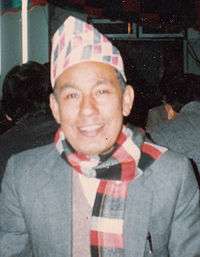Rebati Ramanananda Shrestha
Rebati Ramanananda Shrestha (Devanagari: रेबति रमणानन्द श्रेष्ठ) (1932–2002) was a Nepalese freedom fighter, journalist and Nepal Bhasa author. He also wrote under the pen name R. R. N. Syasya (रे. रे. न. स्यस्य).[1] His works range from poems and epics to essays and short stories.[2] He has written books on history, language, culture and religion.[3]

Early life
Shrestha (alternative names: Rebati Ramanananda Shrestha Vaidya and Revatiramanananda Sreshtha Vaidya) was born in Kathmandu to father Basudevananda and mother Chandra Maya Shrestha. He was educated at Durbar High School in Kathmandu.
Political career
Shrestha joined the underground movement against the Rana dynasty in 1948 while a student at Durbar High. In 1949, he formed an underground organization named Suhrid Mandal to carry on the struggle for democracy in Nepal. The group disbanded as the authorities were beginning to close in on it.
After finishing the School Leaving Certificate (SLC) exams in 1949, Shrestha became general secretary of Rana Bidrohi Mandal ("Anti-Rana Organization") and continued to work in the democracy movement. He gave up active politics and turned to writing and serving Nepal Bhasa following the overthrow of the Rana regime and establishment of democracy in 1951.[4][5]
Writing career
Shrestha enrolled in Nepal National College in 1954. His first publication was Malakha (meaning "Dragon"), a collection of poems, which came out in 1955.[6] In 1956, while a student at Tri-Chandra College, he helped establish Nepal Bhasa Sahitya Pala, an organization of students, with the objective of conducting literary activities in Nepal Bhasa.[7]
Shrestha has served as an editor of Nepal Bhasa literary magazines Thaunkanhe and Nepal. He was an executive member of the Nepal Bhasa Academy.[8]
Publications
Among his notable works are:
- Malakha ("Dragon"), a collection of poems (1955)[9]
- Kapan ("Rainbow"), a collection of short stories (1956)[10]
- Uphoswan ("Blue Lotus"), story (1956)
- Pracina Nepalaya juyivankham ("History of Ancient Nepal"), history (1991)[11]
- Ulah ("Meteor"), a collection of poems (1993)
- Newah, a cultural history (2001)
References
- Bajracharya, Phanindra Ratna (2003). Who's Who in Nepal Bhasha. Kathmandu: Nepal Bhasa Academy. Page 99.
- Tuladhar, Prem Shanti (2000). Nepal Bhasa Sahityaya Itihas: History of Nepalbhasa Literature. Kathmandu: Nepal Bhasa Academy. ISBN 99933-560-0-X. Page 158.
- Tamrakar, Purna Kaji (2004). "My Incomparable Friend: Kesar Lall Shrestha". Archived from the original on 9 September 2012. Retrieved 12 December 2011. Page 82.
- "Profile of R. R. N. Syasya" in Kapan (1956). Kathmandu: Thaunkanhe Prakashan Bibhag.
- Brown, T. Louise (1996). The Challenge to Democracy in Nepal: A Political History. Routledge. ISBN 0415085764, 9780415085762. Page 21.
- Google Books. Retrieved 18 March 2012.
- "Profile of R. R. N. Syasya" in Kapan (1956). Kathmandu: Thaunkanhe Prakashan Bibhag.
- "Nepal Bhasa Academy". Himalayan Research Bulletin. 1991. Retrieved 18 March 2012. Page 140.
- "Library of Congress Catalog Record". Library of Congress. Retrieved 19 March 2012.
- "Library of Congress Catalog Record". Library of Congress. Retrieved 19 March 2012.
- "Library of Congress Catalog Record". Library of Congress. Retrieved 19 March 2012.